
Balmoral Castle is a large estate house in Aberdeenshire, Scotland, and a residence of the British royal family. It is near the village of Crathie, 9 miles (14 km) west of Ballater and 50 miles (80 km) west of Aberdeen.

Princess Louise, Duchess of Argyll was the sixth child and fourth daughter of Queen Victoria and Prince Albert.
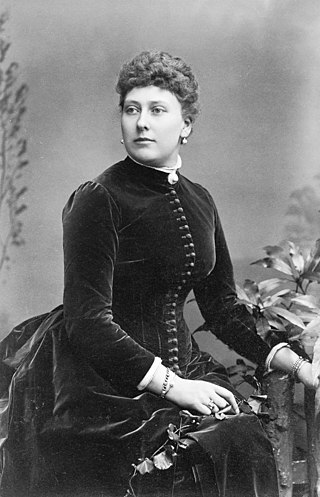
Princess Beatrice, later Princess Henry of Battenberg, was the fifth daughter and youngest child of Queen Victoria and Prince Albert. Beatrice was also the last of Queen Victoria's children to die, nearly 66 years after the first, her elder sister Alice.

Prince Henry of Battenberg, formerly Count Henry of Battenberg, was a morganatic descendant of the Grand Ducal House of Hesse. He became a member of the British royal family by marriage to Princess Beatrice of the United Kingdom, the youngest child of Queen Victoria. Through his daughter, Victoria Eugenie, who became the queen consort of Spain, Henry is a direct ancestor of the current Spanish royal family.

Victoria Eugenie of Battenberg was Queen of Spain as the wife of King Alfonso XIII from their marriage on 31 May 1906 until 14 April 1931, when the Spanish Second Republic was proclaimed. A Hessian princess by birth, she was a member of the Battenberg family, a morganatic branch of the House of Hesse-Darmstadt. She was the youngest granddaughter of Queen Victoria and Prince Albert. Unlike other members of the Battenberg family, who were accorded the lower rank of Serene Highness, Victoria Eugenie was born with the rank of Highness due to a Royal Warrant issued in 1886 by Queen Victoria.

Ballater is a village in Aberdeenshire, Scotland, on the River Dee, immediately east of the Cairngorm Mountains. Situated at an elevation of 213 metres, Ballater is a centre for hikers and known for its spring water, once said to cure scrofula. It is home to more than 1400 inhabitants and has had a long connection with the British royal family.

The River Dee is a river in Aberdeenshire, Scotland. It rises in the Cairngorms and flows through southern Aberdeenshire to reach the North Sea at Aberdeen. The area it passes through is known as Deeside, or Royal Deeside in the region between Braemar and Banchory because Queen Victoria came for a visit there in 1848 and greatly enjoyed herself. She and her husband, Prince Albert, built Balmoral Castle there which replaced an older castle.

Crathie Kirk is a small Church of Scotland parish church in the Scottish village of Crathie, best known for being the regular place of worship of the British royal family when they are in residence at the nearby Balmoral Castle.

Crathie is a village in Aberdeenshire, Scotland. It stands on the north bank of the River Dee.
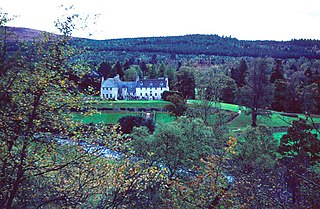
Birkhall is a 210 km2 estate on Royal Deeside, Aberdeenshire, Scotland, owned by King Charles III. It is located alongside the River Muick to the south-west of Ballater.

Prince Maurice of Battenberg KCVO was a member of the Hessian princely Battenberg family and the extended British royal family, and the youngest grandchild of Queen Victoria. He was known as Prince Maurice throughout his life, since he died before the British royal family relinquished their German titles during World War I and the Battenbergs changed their name to Mountbatten.

Queen's Cross is an area in the West End of Aberdeen, Scotland. It is located just west of the main thoroughfare of Union Street and about 1.5 miles (2.4 km) from the geographical town centre at Mercat Cross.

The Deeside Railway was a passenger and goods railway between Aberdeen and Ballater in Aberdeenshire, Scotland. Opening in 1853 to Banchory, an extension reached Aboyne in 1859. A separate company, the Aboyne & Braemar Railway, built an extension to Ballater and this opened in 1866. By 1855 there were five services a day over the 43+1⁄4-mile (69.6 km) long line, taking between 1 hour 50 minutes and 2+1⁄2 hours. The line was used by the Royal Train for travel to and from Balmoral Castle from 1853 and a special 'Messenger Train' ran daily when the Royal Family was in residence.
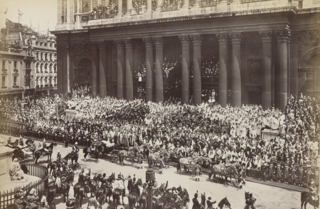
The Diamond Jubilee of Queen Victoria was officially celebrated on 22 June 1897 to mark the occasion of the 60th anniversary of Queen Victoria's accession on 20 June 1837. Queen Victoria was the first British monarch ever to celebrate a Diamond Jubilee.

The Golden Jubilee of Queen Victoria was celebrated on 20 and 21 June 1887 to mark the 50th anniversary of Queen Victoria's accession on 20 June 1837. It was celebrated with a Thanksgiving Service at Westminster Abbey, and a banquet to which 50 European kings and princes were invited.

Royal Lochnagar distillery is a single malt Scotch whisky distillery based on the Abergeldie Estate, near Balmoral Castle in Royal Deeside. It is close to the mountain Lochnagar. The distillery is in the Highland whisky-producing area of Scotland. The distillery holds a Royal Warrant.

Abergeldie Castle is a four-floor tower house in Crathie and Braemar parish, SW Aberdeenshire, Scotland. It stands at an altitude of 840 feet (260 m), on the south bank of the River Dee, five miles (8 km) west of Ballater, and about two miles (3 km) east of the royal residence of Balmoral Castle. Behind it rises Creag nam Ban, a rounded granite hill about 527 metres (1,729 ft) high, and across the river to its front is the cairn-crowned Geallaig Hill, rising to 743 metres (2,438 ft).

Victoria Barracks is a military installation in Ballater, Scotland.
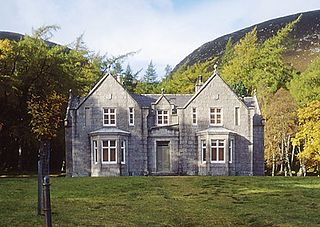
Glas-allt-Shiel is a lodge on the Balmoral Estate by the shore of Loch Muick in Aberdeenshire, Scotland. In its present form it was built in 1868 by Queen Victoria, who called it Glassalt, to be what she called her "widow's house" where she could escape from the world following the death of her husband Albert. It is now a category B listed building owned personally by Charles III. Adam Watson considers that "Glas-allt-Shiel has undoubtedly one of the most spectacular situations of any lodge in the Highlands."
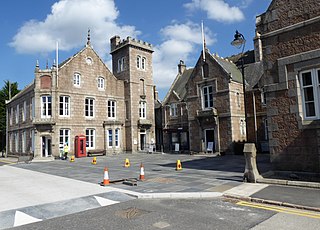
The Victoria and Albert Halls is a complex of municipal buildings in Station Square, Ballater, Aberdeenshire, Scotland. The structure, which accommodates the new Ballater Community and Heritage Hub, is a Category C listed building.





















